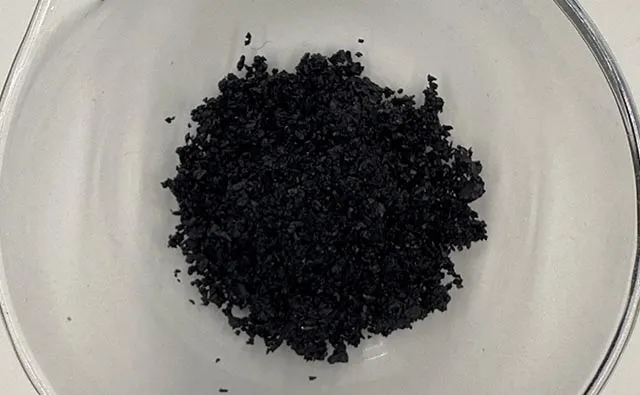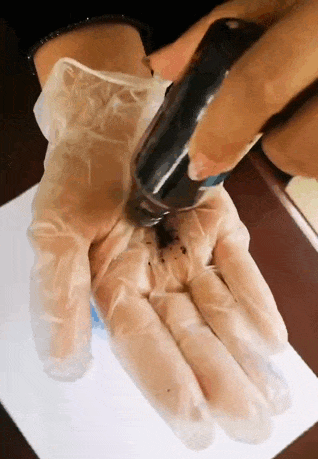Feature Article, Company News, PR
Guaiazulene, Azulene and its derivatives, a class of ancient compounds should be endowed with new chemical applications

Feature Article, Company News, PR

Guaiazulene is a bicyclic sesquiterpene, insoluble in water, sparingly soluble in ethanol, and soluble in chloroform, ether, vegetable oils, and volatile oils. It can be obtained by dehydrogenation of fractions containing Azulene from various plant essential oils, such as chamomile (Matricaria chamomilla L.), eucalyptus leaves, and Australian blue cypress (Callitris intratropica). It appears as crystalline flakes with an admiral blue color. The presence of alkyl groups around it results in poor control over the morphology of bulk heterojunctions, causing the flake-like crystals to turn into oily liquid when the temperature exceeds 28°C. Guaiazulene is also photosensitive, exhibiting phototropism and unique optical properties. It can absorb red light, making it useful in materials that absorb red light. When exposed to light, it changes from blue to green, and finally to yellow. Due to these characteristics, the chemical industry has shifted its focus to studying the optoelectronic properties of azulene, its parent compound[1].

Azulene is composed of an unsaturated seven-membered ring (Cycloheptatriene) and an unsaturated five-membered ring (Cyclopentadiene)[2]. Its dipole moment is 1.08 D, presenting a highly polar asymmetric structure. Alexander St. Pfau and Placidus Plattner suggested that the arrangement of five carbon double bonds (without aromatic rings) in a bicyclic carbon skeleton gives it a beautiful blue color[3,4]. The presence of this color is also believed to result from excited-state photochemical reactions[5]. It absorbs red light in the 600 nm range for the first molecular transition (S1), and then absorbs light in the 330 nm range for the second excited-state transition (S2). After absorbing light, the molecule becomes excited and moves to higher energy states[6]. Meanwhile, both azulene and guaiazulene undergo photolysis under UVA light[6]. Naphthalene is an isomer of azulene, but it is markedly different from azulene. The structure is non-polar and only absorbs light in the 315 nm range[2].
The generic name ‘Azulene’ was first coined and used by Septimus Piesse in 1864[7], where ‘azul’ means blue in Spanish. Over time, it gradually became the root word for a series of compounds with the formula C10H8. Azulene obtained from guaiacol is written as ‘guaiazulene’, while that obtained from vetiver oil is called ‘vetivazulene’. Additionally, there are compounds such as chamazulene (extracted from chamomile oil), patchouliazulene (extracted from patchouli oil), eucalyptazulene (extracted from eucalyptus oil), and aloesazulene (extracted from aloe oil), among others. The word “guaiazulene” is now more widely used, and many treat “guaiazulene” as synonymous with “Azulene” in some expressions, or use “Azulene derivatives” to refer to related substances.
In the Asian pharmaceutical market, guaiazulene is formulated into guaiazulene ointment (Guaiazulene Ointment) because of its anti-inflammatory, anti-allergic, and wound-healing effects. This ointment is used as raw material for burn ointments (Chinese Pharmaceutical Standard H31023060) and skin inflammation ointments (Azunol Ointment 0.033%). In the European and American markets, it is formulated into skin ointments like Azulenal® Ointment, which is used for anal fissures, cracked nipples of breastfeeding mothers, and diaper rash in infants. According to these companies, the guaiazulene is often sourced from eucalyptus trees.
A newer pharmaceutical application involves using guaiazulene and podophyllotoxin to prepare nano-prodrugs for nanoparticle-based drug delivery systems[8] for cancer treatment.
Guaiazulene is approved by the FDA as a cosmetic colorant due to its beautiful blue color. However, studies have raised concerns about guaiazulene or azulene producing reactive oxygen species (ROS), such as superoxide radicals, when exposed to prolonged light. These radicals can induce lipid peroxidation, which may pose health risks with prolonged use of cosmetics containing guaiazulene or azulene when exposed to sunlight[2]. Therefore, the current FDA approval does not include the use of guaiazulene or azulene in cosmetics formulations for the eye and lip areas.
Currently available guaiazulene is mostly used in calming soothing facial cleansers and moisturizers. Its anti-inflammatory and cell growth-promoting properties are utilized to alleviate facial skin allergies. Examples include Klairs Midnight Blue Calming Cream from SoKoSkins and Post Alpha pH-Balancing Gel Cleanser from Cell Fusion C. It can also be used in low-allergenicity face masks, such as Hypoallergenic Cica Gauze Mask by Dermatory. It can also be found in toners, makeup removers, and serums, like Sunhan Salgyeolsu Water Toner by 2Sol and Calming Cica Tree Micellar Cleansing Water by Neogen Dermalogy.
Azulene derivatives show a redshift and broader absorption spectra compared to naphthalene derivatives. Naphthalene derivatives demonstrate higher photovoltaic efficiency compared to azulene derivatives[9]. Current research has shown that extending the conjugated structure by substituting aromatic groups for the seven-membered ring can greatly influence the optical and electrochemical properties of the azulene cation[10]. This reversible chromatic property can be applied to cathode modification layers in bulk-heterojunction solar cells, as well as in electrochromic and nonlinear optical materials.
Research has shown that thin films of red-absorbing photovoltaic materials obtained through oxidative polymerization of guaiazulene and ferric chloride exhibit higher absorption cross-sections and can display brighter green colors compared to films prepared by traditional solution methods[1]. Due to the unique resonance structure of azulene, especially its derivatives such as 16a-f, 17a-i, 18a-h, and 19a-h, they are considered promising building blocks for organic optoelectronic materials[11]. The method of synthesizing azulene derivatives by constructing the azulene skeleton with appropriate substituents at desired positions is considered a way to address the high cost associated with directly modifying azulene to produce derivatives.